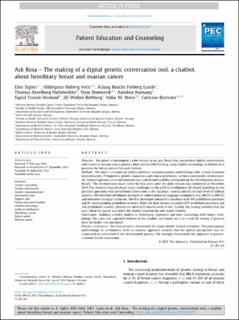| dc.contributor.author | Siglen, Elen | |
| dc.contributor.author | Vetti, Hildegunn Høberg | |
| dc.contributor.author | Lunde, Aslaug Beathe Forberg | |
| dc.contributor.author | Hatlebrekke, Thomas Akselberg | |
| dc.contributor.author | Strømsvik, Nina | |
| dc.contributor.author | Hamang, Anniken | |
| dc.contributor.author | Hovland, Sigrid Tronsli | |
| dc.contributor.author | Rettberg, Jill Walker | |
| dc.contributor.author | Steen, Vidar Martin | |
| dc.contributor.author | Bjorvatn, Cathrine | |
| dc.date.accessioned | 2022-02-28T14:12:47Z | |
| dc.date.available | 2022-02-28T14:12:47Z | |
| dc.date.created | 2021-11-03T12:08:19Z | |
| dc.date.issued | 2021 | |
| dc.identifier.citation | Siglen, E., Vetti, H. H., Lunde, A. B. F., Hatlebrekke, T. A., Strømsvik, N., Hamang, A., Hovland, S. T., Rettberg, J. W., Steen, V. M., & Bjorvatn, C. (2021). Ask Rosa – The making of a digital genetic conversation tool, a chatbot, about hereditary breast and ovarian cancer. Patient Education and Counseling. | en_US |
| dc.identifier.issn | 0738-3991 | |
| dc.identifier.uri | https://hdl.handle.net/11250/2981781 | |
| dc.description.abstract | Objective We aimed at developing a pilot version of an app (Rosa) that can perform digital conversations with breast or ovarian cancer patients about genetic BRCA testing, using chatbot technology, to identify best practices for future patient-focused chatbots. Methods We chose a commercial chatbot platform and participatory methodology with a team of patient representatives, IT engineers, genetic counselors and clinical geneticists, within a nationwide collaboration. An iterative approach ensured extensive user and formal usability testing during the development process. Results The development phase lasted for two years until the pilot version was completed in December 2019. The iteration steps disclosed major challenges in the artificial intelligence (AI)-based matching of user provided questions with predefined information in the database, leading initially to high level of fallback answers. We therefore developed strategies to reduce potential language ambiguities (e.g. BRCA1 vs BRCA2) and overcome dialogue confusion. The first prototype contained a database with 500 predefined questions and 67 corresponding predefined answers, while the final version included 2257 predefined questions and 144 predefined answers. Despite the limited AI functionality of the chatbot, the testing revealed that the users liked the layout and found the chatbot trustworthy and reader friendly. Conclusions Building a health chatbot is challenging, expensive and time consuming with today’s technology. The users had a positive attitude to the chatbot, and would use it in a real life setting, if given to them by health care personnel. Practice implications We here present a framework for future health chatbot initiatives. The participatory methodology in combination with an iterative approach ensured that the patient perspective was incorporated at every level of the development process. We strongly recommend this approach in patient-centered health innovations. | en_US |
| dc.language.iso | eng | en_US |
| dc.publisher | Elsevier | en_US |
| dc.rights | Navngivelse 4.0 Internasjonal | * |
| dc.rights.uri | http://creativecommons.org/licenses/by/4.0/deed.no | * |
| dc.subject | genetic counseling | en_US |
| dc.subject | genetic information | en_US |
| dc.subject | genetic communication | en_US |
| dc.subject | information tool | en_US |
| dc.subject | support tool | en_US |
| dc.subject | patient educationchatbot | en_US |
| dc.subject | chatbot technology | en_US |
| dc.subject | artificial intelligence | en_US |
| dc.subject | hereditary cancer | en_US |
| dc.subject | breast cancer | en_US |
| dc.subject | ovarian cancer | en_US |
| dc.title | Ask Rosa – The making of a digital genetic conversation tool, a chatbot, about hereditary breast and ovarian cancer | en_US |
| dc.type | Peer reviewed | en_US |
| dc.type | Journal article | en_US |
| dc.description.version | publishedVersion | en_US |
| dc.rights.holder | © 2021 The Author(s) | en_US |
| dc.source.pagenumber | 7 | en_US |
| dc.source.journal | Patient Education and Counseling | en_US |
| dc.identifier.doi | 10.1016/j.pec.2021.09.027 | |
| dc.identifier.cristin | 1950966 | |
| cristin.ispublished | true | |
| cristin.fulltext | postprint | |
| cristin.fulltext | original | |
| cristin.qualitycode | 2 | |

